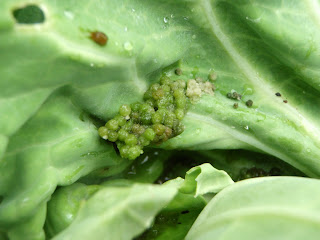Vegetable: Spinach (Spinacea oleracea)Variety: Bloomsdale Savoy, Oriental Giant
Seed Co: Territorial Seed Co.
Description:
Bloomsdale: Dark green savoyed leaf, a spring and fall spinach
Oriental Giant: fast, large leaved, bolt resistant for a quick maturing variety
 Bloomsdale spinach at harvest
Bloomsdale spinach at harvest
Sown: 02/24, 03/09, 04/27
Germination: sowed 4" wide bands, 1st sowing at end of Feb was poor, 2 week later sowing was average, Oriental giant at end of April was good
First Harvest: 05/15
Days to maturity:
Bloomsdale Stated:
50 Actual: 51
Oriental Stated:
40 Actual: none
Held in field: 7-10 days
Problems: I really had trouble with spinach this year. I sowed before a few weeks of unseasonably warm and sunny weather in late February, so germination was good. Cold, wet weather (including snow) later on pretty much wiped out the first sowing. A second sowing 2 weeks later came up and grew much better so I was able to harvest a few plants. The last sowing of Oriental giant at the end of April germinated well, but grew very slowly and did not produce leaves of edible size. All remaining spinach bolted last week.

Bolting! Bloomsdale on left and tiny Oriental "giant" on right.
Results: Spinach is known for being more difficult to grow well than other greens. Next time I will try to sow at more appropriate times to ensure better performance. Choosing the right variety at the right time is crucial: a quick maturing variety like Oriental Giant could be sown in spring a bit later than longer varieties if I must wait for good weather. Later on, a heat tolerant and bolt resistant variety like Correnta could be sown to help prolong harvest into hotter June weather. I may have not provided enough nitrogen either. Spinach is a heavy feeder. The organic fertilizers I use need to be broken down in the soil before nutrients are available for plants. In the cold, wet soil in February, biological activity is minimal, so those nutrients are not being released. Perhaps liquid fertilizer solution will work better. I'll try a fall crop this summer and try again.
 The infamous corn flea beetle on the tomatoes. Numbers aren't bad enough to do any real damage, with plants at 3' already. These guys can mow down entire stands of young transplants overnight when there are enough of them. I'll keep an eye on the damage and worse case (plants start suffering) use neem oil.
The infamous corn flea beetle on the tomatoes. Numbers aren't bad enough to do any real damage, with plants at 3' already. These guys can mow down entire stands of young transplants overnight when there are enough of them. I'll keep an eye on the damage and worse case (plants start suffering) use neem oil. This honeybee OD'ed on pollen.
This honeybee OD'ed on pollen.














